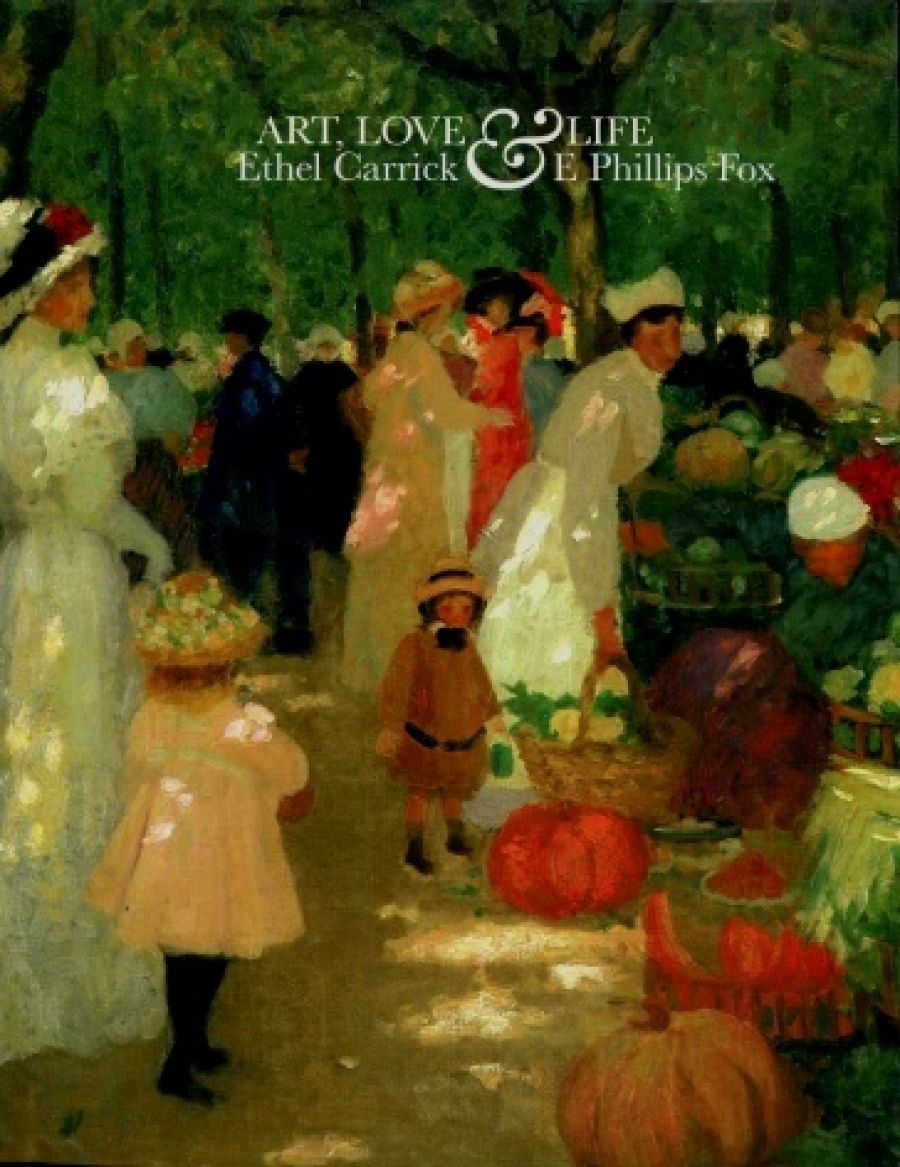
- Free Article: No
- Contents Category: Art
- Review Article: Yes
- Online Only: No
- Custom Highlight Text:
Art, Love and Life accompanies the exhibition of the same name at the Queensland Art Gallery. This substantial book contains eight short essays by six authors, with a brief checklist of the works included in the exhibition towards the end of the publication. There is also a useful chronology.
- Book 1 Title: Art, Love and Life
- Book 1 Subtitle: Ethel Carrick and E. Phillips Fox
- Book 1 Biblio: Queensland Art Gallery/Gallery of Modern Art, $45 pb, 174 pp
This is the first publication to look at the work of the married couple E. Phillips Fox and Ethel Carrick, and to consider their shared influences and passions, and the differences in their techniques and practices. It focuses on a select period of their work: from 1905, when they married, to 1915, the year Fox died. In providing this close focus on these highly productive years, the book throws new light on their art.
During the Edwardian era, there were a number of artistic husband-and-wife partnerships, such as George Coates and Dora Meeson, Harold and Laura Knight, Vanessa Bell and Duncan Grant. Sometimes one partner was more dominant than the other, but with Fox and Carrick it appears to have been a genuine partnership, though Carrick always deferred to Fox as the more important artist. This exhibition and publication provide the opportunity to compare and contrast their work, and to decide for ourselves whether she was right.
Angela Goddard, curator of the exhibition and principal author of the book, contributes three essays. In the first, she discusses the marriage between Fox and Carrick, and provides an introduction to Fox’s work before his marriage. She also discusses modernity in motion Ethel Carrick’s crowds. She observes that Carrick’s interest in depicting people in public spaces contrasts markedly with Fox’s preference for depicting women within private settings. Finally, she looks at Carrick’s final years, her interest in theosophy, and her friendships with women artists.
Two essays consider Edwardian expatriatism. Karen Quinlan explores the lure of England and the attraction of the English coastal village of St Ives, where the two artists met. She places Fox’s work among that of contemporary British artists and looks at the artists’ interest in profiling their work at the Royal Academy. Georgina Downey examines cosmopolitans and expatriates, and Carrick and Fox in Paris. She considers whether Carrick and Fox merely depicted the Edwardian pursuit of ‘cultivated recreation’ for pleasure’s sake, or whether their works also evoke memory and desire, and thereby provide insight into the Edwardian mind and heart.

Juliette Peers explores fashion and dress in their work. She points to their artist’s wardrobe and its shared use in their paintings. In her close analysis of this particular aspect of their work, Peers provides valuable insights into the different approaches of Fox and Carrick to their paintings.
Andrew Yip looks at the two artists in the Orient. By focusing on a single phase of the two artists’ work, he shows how their voyage to Algeria and Morocco influenced what they painted, with Fox venturing beyond his usual intimiste subjects to embrace a more vibrant approach, and with Carrick exploring a modernist play of colour and form.
Catherine Nunn, senior painting conservator at the University of Melbourne, discusses some aspects of the materials and techniques of the Foxes in her essay. She notes their working method (painting quickly outdoors) and their use of ‘broken colour’ on small wooden panels.
Ruth Zubans has devoted much of her life to undertaking research into both Fox and Carrick (she has published a substantial book on him); the acknowledgments pay tribute to her as an expert reader.
This is a significant publication on two major artists and an essential reference for anyone interested in the story of Australian art. If I have a quibble, it is with the arrangement of illustrations, which are organised to complement the essays. This makes perfect sense in a book, but is frustrating for those who might want to use the publication as an exhibition catalogue, or to get an idea of the chronological development of the artists’ work. A compromise would have been to include small-scale images of each work alongside the entry in the checklist (as in the Tom Roberts retrospective exhibition book), rather than to provide a frustrating page reference at the end of the entry. Likewise, it is irritating that the checklist is not numbered, and that references to the checklist, or to the pages where the works are reproduced, are not included in the essays. This makes it difficult to look at the works referred to in the essays when these are not included nearby. This is exacerbated by the lack of an index. Both cross-referencing and indexing are time-consuming editorial tasks, but essential for any publication to be a truly useful reference work. A number of publishers I have met would prefer to do away with them, but authors and readers should stand their ground and insist on them. Apart from this minor flaw, Art, Love and Life makes an important contribution to our knowledge of Fox and Carrick.


Comments powered by CComment